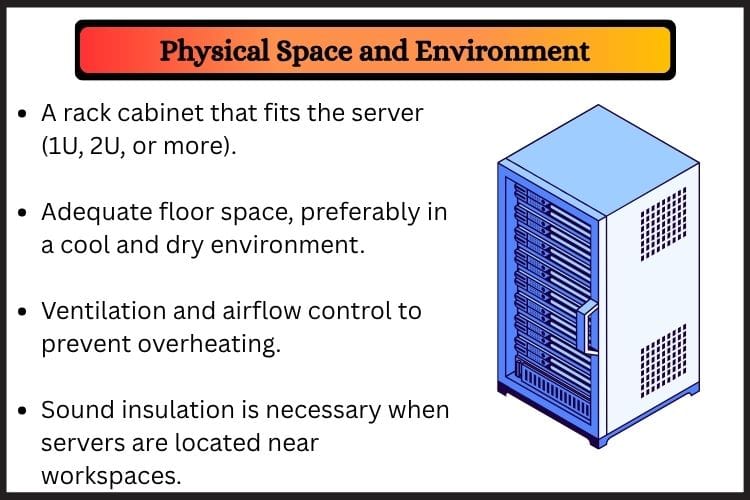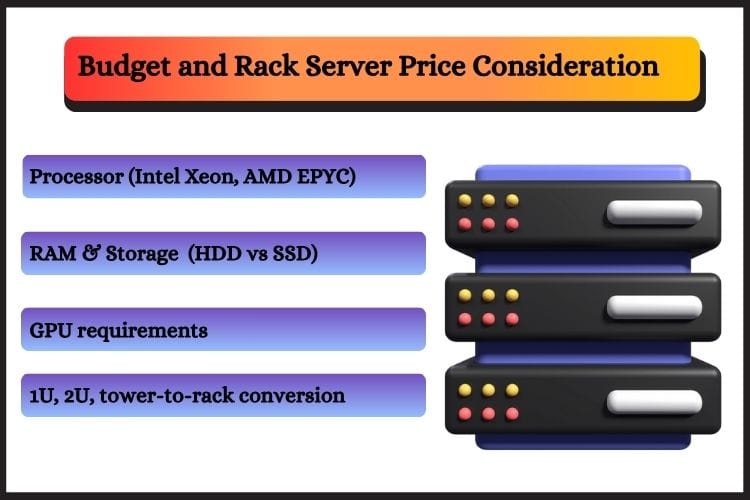Table of Contents
In today’s digital-first world, owning a rack server is no longer limited to big enterprises. Whether you’re running a small business, managing a data-driven startup, or building a home lab, setting up your rack server gives you unmatched control, scalability, and cost efficiency. But before you buy a rack server, it’s crucial to understand the fundamental requirements for setting one up effectively.
In this blog, we’ll walk you through the basic needs to set up your own rack server, explore different types such as 2U rack servers and GPU rack servers, and help you find the best rack server for small business operations.
What is a Rack Server?
A rack server is a type of computer server designed to be installed within a rack-like framework. To save room and keep things organized, these servers are typically stacked vertically in a server rack cabinet. Various configurations are available depending on workload and performance needs, ranging from 2U rack servers to sophisticated GPU rack servers.
Contact us
For data centers, web hosting, application servers, and companies needing scalable infrastructure, rack servers are excellent.
Basic Requirements to Set Up Your Own Rack Server
If you’re planning to buy a rack server for your business or personal data center, here are the essentials you need to consider:
1. Choosing the Right Server Type
Before diving into setup, it’s essential to choose the best rack server for your small business or enterprise based on workload type:
- 1U/2U Rack Server: These are compact and suitable for most business operations.
- A 2U rack server provides more space for cooling, memory, and storage.
- GPU Rack Server: Best for artificial intelligence, machine learning, or graphics-intensive tasks.
- High-Density Rack Server: Best for large data centers needing maximum performance in minimal space.
At Serverstack, we offer a range of cheap rack servers without compromising on quality or performance.
2. Physical Space and Environment

You’ll need:
- A rack cabinet that fits the server (1U, 2U, or more).
- Adequate floor space, preferably in a cool and dry environment.
- Ventilation and airflow control to prevent overheating.
- Sound insulation is necessary when servers are located near workspaces.
3. Power Requirements
Servers consume more power than typical desktop systems. Ensure:
- You have access to dedicated power outlets.
- For backup in the event of a power outage, use an uninterruptible power supply (UPS).
- Monitor energy usage and install power distribution units (PDUs) inside the rack for efficient load management.
4. Cooling System
High-performance servers generate significant heat. You’ll need:
- Proper airflow within the rack cabinet.
- Room ventilation or HVAC system.
- Optional liquid cooling solutions for GPU-heavy workloads.
5. Networking Infrastructure
Your rack server setup needs a stable and secure network.
- Network switches with enough ports.
- High-speed Ethernet cables (Cat6 or Cat7).
- Firewall and VPN configuration for secure access.
- Internet with redundant connection paths for uptime reliability.
6. Data Storage and Backup
Plan your storage according to usage:
- RAID configurations for redundancy and performance.
- Backup strategies with external NAS or cloud backup.
- Scalable storage solutions if you expect business growth.
Serverstack provides expert advice on storage configurations for every server we offer.
7. Security and Monitoring Tools
Security should never be compromised.
- Server firewall and intrusion detection system (IDS).
- Access control (biometric or RFID for the physical server room).
- Remote monitoring tools for temperature, usage, and uptime.
- We help you integrate the best monitoring solutions with your Serverstack rack servers.
8. Installation and Setup
You can install the server OS yourself or get help from a professional.
- Choose the right operating system (Linux, Windows Server, or VMware).
- Configure your services (web, email, file sharing, etc.).
- Use remote management tools like iDRAC, IPMI, or KVM switches.
If you’re unsure, Serverstack’s support team can assist you in setting up and configuring your server.
9. Budget and Rack Server Price Consideration

For financial planning, it is essential to understand the rack server pricing structure. The following factors affect prices:
- Processor (Intel Xeon, AMD EPYC)
- RAM capacity
- Storage type (HDD vs SSD)
- GPU requirements
- Form factor (1U, 2U, tower-to-rack conversion)
At Serverstack, we offer cheap rack servers that are powerful, customizable, and reliable—perfect for businesses with any budget.
Why Buy a Server from Serverstack?
Choosing the right vendor is as important as choosing the right server. Here’s why Serverstack stands out:
- 🔒 Reliable & Tested Hardware
- 🔄 Custom Configurations for Your Business Needs
- 💡 Expert Consultation & Support
- 💰 Affordable Rack Server Prices Without Compromising Quality
- 🚚 Fast Delivery and Easy Setup Assistance
Whether you need a 2U rack server, a GPU rack server, or the best rack server for your small business, Serverstack has you covered.
Conclusion
Setting up a rack server doesn’t have to be complicated or expensive. With Serverstack, you get the right advice, affordable pricing, and ongoing support that scales with your business.
Contact us today to receive a custom quote or explore our catalog of affordable rack servers, designed for optimal performance and reliability.
Frequently Asked Questions
1. What is the purpose of a rack server?
A rack server is used to efficiently manage computing power, storage, and networking in a compact space. It’s best for businesses that require secure, scalable, and high-performance systems for hosting websites, applications, or internal systems.
2. Should I choose a GPU rack server?
If your workload involves machine learning, AI, rendering, or high-performance computing, then a GPU rack server is essential. These servers are equipped with powerful graphics cards to handle demanding parallel processing tasks.
Serverstack provides customizable GPU servers for businesses with specialized needs.
3. Can I use a rack server for a small business?
Absolutely. A rack server can be the best server for small business operations due to its scalability and space-saving design. It can host files, applications, backups, emails, and more—all from a centralized location.
4. Can I set up the server on my own, or do I need technical support?
While technically inclined users may set up a server on their own, most businesses benefit from professional assistance. Serverstack provides setup and configuration support to ensure your rack server performs optimally and securely from day one.







